#background dwarf star
Explore tagged Tumblr posts
Text
Dad!Simon Taking Your Daughter to the Optician’s (Fluff)
another random one but OMG imagine your daughter had needed those adorable baby glasses and simon took her to the optician to buy a pair 😭 like awwwwweewwwwwwwwe purest domestic fluff ever, not proofread

He pulls her tiny, pink raincoat off of the coat hangers by the door, along with his own black bomber jacket that he holds under one arm, and he tenderly leans down to zip up her little jacket - the one with cutesy rubber ducks embroidered at the cuffs. Most people wouldn’t immediately assume them to be father and daughter. This huge, intimidating military man with sunglasses on in early Spring to hide his eyes and a small silver dog tag dangling down around his neck, dwarfed by his broad shoulders - and reaching her hand up to hold his, babbling something unintelligible about rocks, a little girl. Her hair was carefully tied into bunches - Simon had tried to do it himself but he somehow managed to miss out half of her hair, so he lifted her up over his shoulder as if he were a firefighter and went to find you.
"Y’married a soldier, not a hairdresser," he grinned, a little bit embarrassed.

At the optician’s, he guides his little girl around the room, inspecting the shelves of different glasses. He holds her soft, little hand in his big, tough one. For a moment, he is distracted by some informational poster on the wall, but a sudden exasperated gasp from the 3 year old at his feet pulls him back to reality right away. Looking down, he sees her chubby hands holding a pair of adult sunglasses to her eyes, a big grin on her face.
"Glasses! Want glasses, daddy!" she giggles, the specs falling wonky on her little button nose. Simon laughs softly, crouching down to get closer to his baby, his elbows resting on the denim of his jeans.
"You can have glasses, love… but those are too big for a littl’un like you," he leans in to kiss her soft forehead, and tries to place the sunglasses back, as her little fingers paw at them.
"What about these ones..?" he smiles, holding out a little pair of pink glasses, purple at the edges, with sweet little stars along the sides. That smile on his face is met by her exaggerated, pleading eyes and her little sad pout, still trying to reach her hands out to the sunglasses that her daddy had meanly placed on a high shelf. :(
Simon finally settles on buying the sunglasses ‘for himself’, rolling his eyes with a small chuckle as he helps fit those cute, purple glasses to his little girl’s face, turning her to look at herself in the mirror of the shop.
"Ahh!" she lets out a little, excited squeal, "I love it, Daddy!"
"You look so pretty, little girl," he smiles protectively, trying not to laugh as he sees her chubby, grinning face looking up at him behind those glasses that make her eyes seem twice as big as normal.
Her little mary-jane shoes run in circles around the shop, as she lets out little squeaks of joy and mumbles to herself - in the end, it takes your husband a whole 10 minutes to convince her to take them off so that he can buy them, and on the walk home she does her best to speed ahead of him (not that he would ever actually allow her out of his sight), shouting, "Faster, Daddy!", alternating between running away from him and walking slow at his side, panting from the running until he caved and carried her. She was just so excited and couldn’t wait to go home and show Mummy. <3
And she looks so cute when she excitedly rushes into the kitchen, screwing up her face and giggling as she tells you all about her new glasses, Simon leaning against the doorframe in the background and chuckling softly as he watches, unable to hide how much he loves his little family.

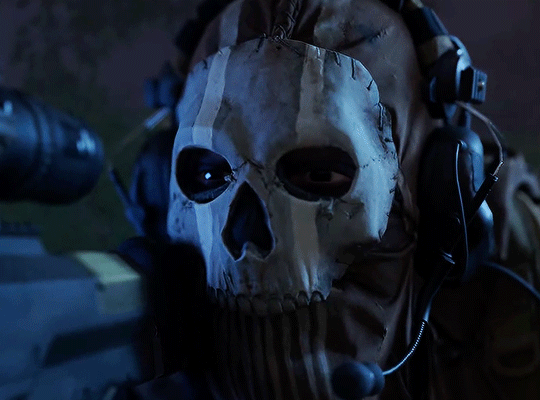
i love him so much i’m crying tears thanks for reading lovelies! x
#cod mw2#simon ghost riley#cod#ghost#ghost x reader#ghost x you#fluff#headcanon#simon riley x reader#simon riley x you#dad!ghost#simon riley#call of duty#girl dad!ghost#simon ghost x reader#ghost cod#ghost fluff#cod mwii#cod headcanons#cod x reader#cod modern warfare
843 notes
·
View notes
Text
Tolkien OC Week
A fandom event for OCs and underdeveloped characters in Tolkien's world!
This event celebrates both characters of Tolkien's world and our own characters that need more love, by creating and reblogging all kind of fanworks, like fanfiction, fanart, fanvideos, fancrafts, headcanons, playlists, edits, moodboards etc.
The event is modded by @yellow-faerie, @elamarth-calmagol and @stormxpadme and will take place between 25th August - 31st August 2024 for the fourth year running.
NSFW text entries are allowed and we’ll tag them accordingly when we reblog them, but please put them behind a “read more”.
We'll also be tracking the tag #tolkienocweek during this week!
*******************************************
Event schedule for 2024:
Day 1 (25th August): World Building
Create a fanwork about an original character, and use them as a jumping off point for worldbuilding. Share a dwarf from the far side of Rhun, consider the existence of an Aina before the creation of Arda, explore Rivendell from the point of view of an outsider, or tell us about the underground punk subculture of Gondolin.
Day 2 (26th August): Canon-OC Relationships
This year, it’s not just about romance. Today, explore a relationship between your OC and a canon character. Your character could be a lover or spouse of someone canonical, lf course, but they could also be a friend, sibling, teacher, servant, fan, or even rival!
Day 3 (27th August): Alternate Universes
Share an OC who isn’t canon compliant at all. Maybe you want to add a fourteenth member of Thorin’s company or give a reborn Celebrimbor children with a surviving and reformed Sauron. Or, maybe you want to do a crossover with your Star Wars OC or let your self-insert narrate a coffee shop AU. Go wild!
Day 4 (28th August): Gaps and Ghosts
Create a fanwork based upon a character that Tolkien either thought up and abandoned, such as Odo Took oe the characters of The New Shadow. Or, create someone he missed creating in the first place, like… um… just about anyone’s mother.
Day 5 (29th August): Non-Humanoid Characters
Middle Earth isn't just elves, Men, hobbits, and dwarves. Today, share a character who is something different entirely: an animal, a dragon, a Maia who doesn't take humanoid form, an ent or huron, or a creature of your own invention.
Day 6 (30th August): Background Characters
This prompt is all about people who are in the background of the action: the low-ranking soldiers, the servants, and the ordinary people living in extraordinary times. Or maybe you want someone who isn't so ordinary, like an advisor in the Council of Elrond who never made it onto the page, or one of the Maiar who sank the Feanorians on the stolen boats. Show us their view of the action!
Day 7 (31st August): Freeform
Did we miss something? Do you have an OC that doesn’t fit into any day, or did you want to do a second fanwork for one of the days? Today, create and share whatever you want, as long as it has to do with original or abandoned characters!
*******************************************
*******************************************
Since we want to celebrate creations about neglected characters all year long, the mods will occasionally reblog posts and fancreations about OCs and underdeveloped characters. If you would like to see your post on our blog, you're very welcome to tag tolkienocweek. Since tumblr's tagging system is often being faulty, don't hesitate to message us, too!
We are looking forward to see and share all the awesome work you come up with!
#lotr#lord of the rings#the hobbit#hobbit#the hobbit movies#lotr movies#silm#the silm#silmarillion#the silmarillion#tolkien#the legendarium#ocs#original characters#tolkienocweek
207 notes
·
View notes
Note
How did you go about getting hired by the Astrea game team? Did you apply to them, did they approach you, or were you part of the original team? If not the last option, how much "lore" did the game have before you joined, vs how much changed/was influenced by your addition to the team and contribution to the project?
They contacted me on Instagram looking for help from an art director to do a complete redesign of the art for their game, which was in early development. Here on Artstation there are some old images from before I joined the team:
There are a few more things in the Digital Artbook that can be obtained on Steam if you want!
The lore changed completely after I took over as art director. The original story was about medieval and fantasy-themed animals fighting to uncorrupt a magical forest. Corruption was represented as purple miasma and purification as green essence. They were taking inspiration from Armello at the time.
I changed the whole concept to revolve around a mystical star and cosmic theme. I changed the concept of corruption and purification to something related to the two paths a star can take after death, becoming a black hole or a bright white dwarf star.
My idea was to change the name of the two dual forces as well, it was supposed to be something like “Ascension and Collapse” or "Rise and Fall", but they decided to keep “Purification and Corruption” because it was easy to understand.
Here's the trailer for others who want to check it out!
youtube
88 notes
·
View notes
Photo

2024 July 12
Jones-Emberson 1 Image Credit & Copyright: Team OURANOS, (Jean-Baptiste Auroux, Jean Claude Mario, Mathieu Guinot & Matthieu Tequi)
Explanation: Planetary nebula Jones-Emberson 1 is the death shroud of a dying Sun-like star. It lies some 1,600 light-years from Earth toward the sharp-eyed constellation Lynx. About 4 light-years across, the expanding remnant of the dying star's atmosphere was shrugged off into interstellar space, as the star's central supply of hydrogen and then helium for fusion was depleted after billions of years. Visible near the center of the planetary nebula is what remains of the stellar core, a blue-hot white dwarf star. Also known as PK 164 +31.1, the nebula is faint and very difficult to glimpse at a telescope's eyepiece. But this deep image combining over 12 hours of exposure time does show it off in exceptional detail. Stars within our own Milky Way galaxy as well as background galaxies across the universe are scattered through the clear field of view. Ephemeral on the cosmic stage, Jones-Emberson 1 will fade away over the next few thousand years. Its hot, central white dwarf star will take billions of years to cool.
∞ Source: apod.nasa.gov/apod/ap240712.html
83 notes
·
View notes
Text
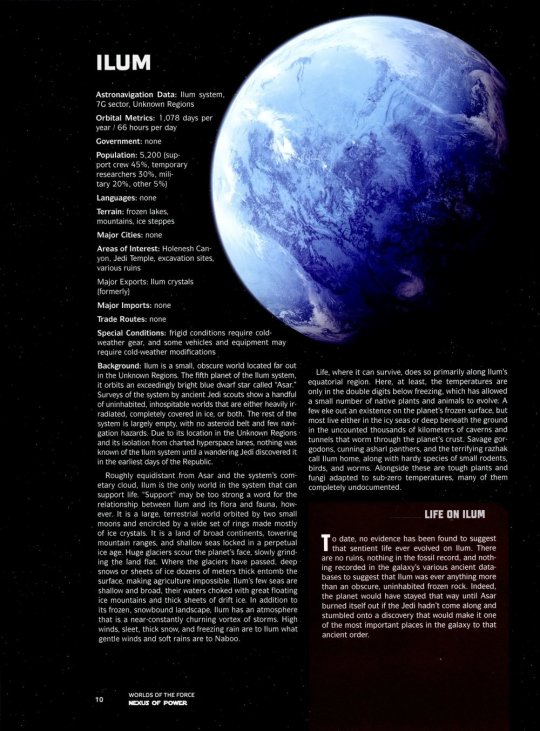
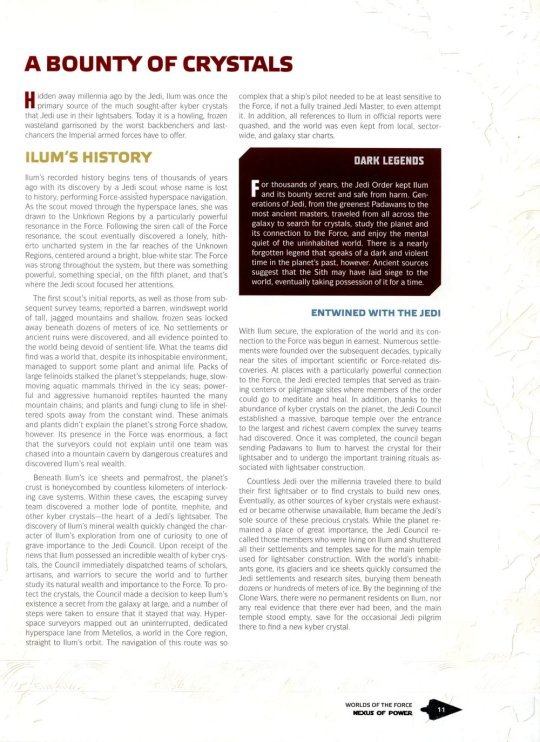
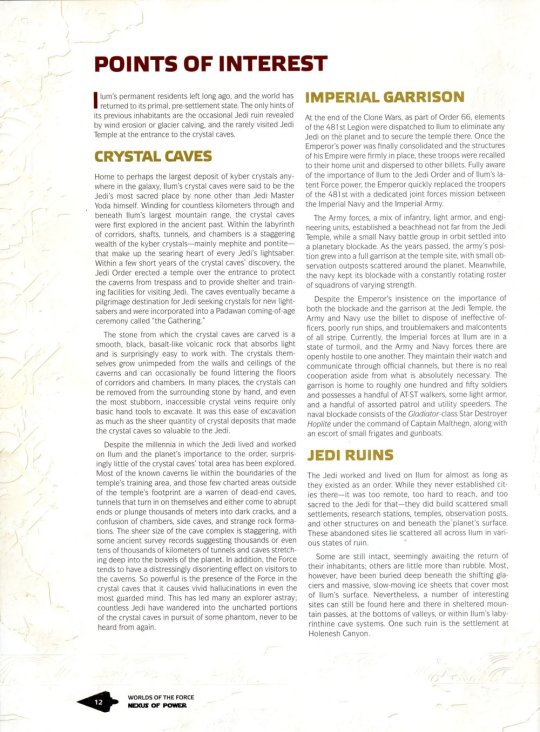
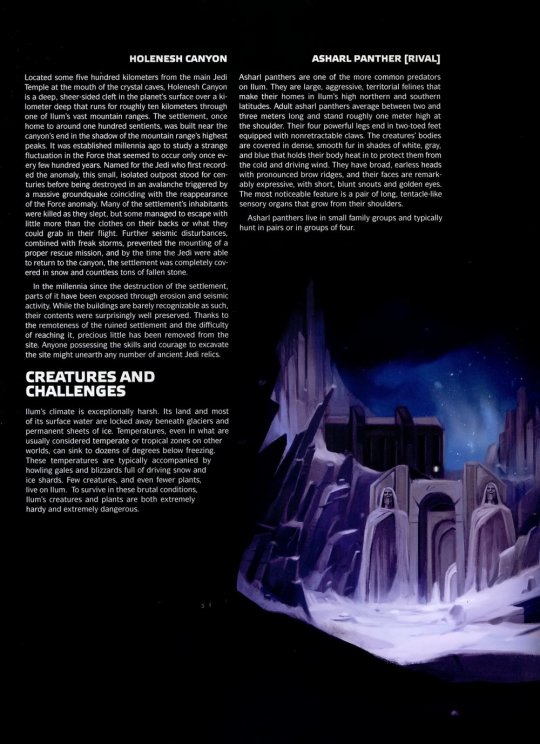
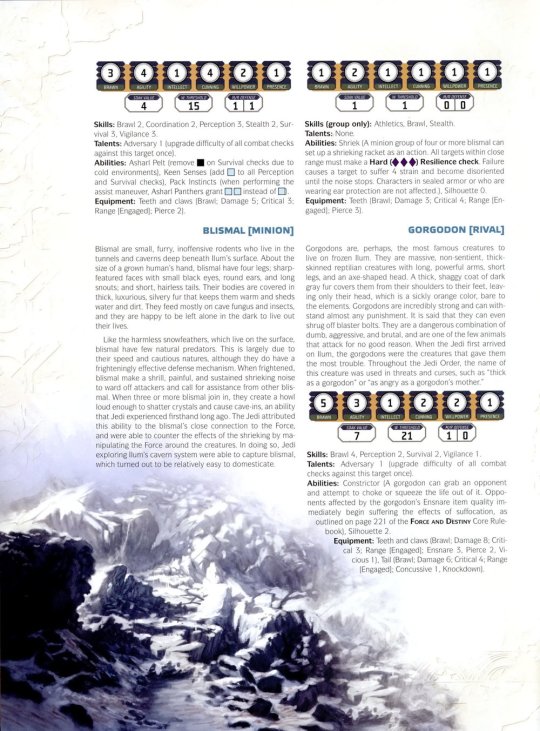

PLANET: ILUM Astronavigation Data: Ilum system, 7G sector, Unkonwn Regions Orbital Metrics: 1,078 days per year/66 hours per day Goverment: None Population: 5,200 (support crew 45%, temporary researchers 30%, military 20%, other 5%) Languages: None Terrain: Frozen lakes, mountains, ice steppes Major Cities: None Areas of Interest: Holenesh Canyon, Jedi Temple, excavation sites, various ruins Major Exports: Ilum crystals [Source: Star Wars - Force and Destiny - Nexus of Power - Force Worlds] BACKGROUND: Ilum is a small, obscure world located far out in the Unknown Regions. The fifth planet of the Ilum system, it orbits an exceedingly bright blue dwarf star called “Asar.” Surveys of the system by ancient Jedi scouts show a handful of uninhabited, inhospitable worlds that are either heavily irradiated, completely covered in ice, or both. The rest of the system is largely empty, with no asteroid belt and few navigation hazards. Due to its location in the Unknown Regions and its isolation from charted hyperspace lanes, nothing was known of the Ilum system until a wandering Jedi discovered it in the earliest days of the Republic.
Roughly equidistant from Asar and the system’s cometary cloud, Ilum is the only world in the system that can support life. “Support” may be too strong a word for the relationship between Ilum and its flora and fauna, however. It is a large, terrestrial world orbited by two small moons and encircled by a wide set of rings made mostly of ice crystals. It is a land of broad continents, towering mountain ranges, and shallow seas locked in a perpetual ice age. Huge glaciers scour the planet’s face, slowly grinding the land flat. Where the glaciers have passed, deep snows or sheets of ice dozens of meters thick entomb the surface, making agriculture impossible. Ilum's few seas are shallow and broad, their waters choked with great floating ice mountains and thick sheets of drift ice. In addition to its frozen, snowbound landscape, Ilum has an atmosphere that is a near-constantly churning vortex of storms. High winds, sleet, thick snow, and freezing rain are to Ilum what gentle winds and soft rains are to Naboo.
Life, where it can survive, does so primarily along Ilum's equatorial region. Here, at least, the temperatures are only in the double digits below freezing, which has allowed a small number of native plants and animals to evolve. A few eke out an existence on the planet’s frozen surface, but most live either in the icy seas or deep beneath the ground in the uncounted thousands of kilometers of caverns and tunnels that worm through the planet’s crust. Savage gorgodons, cunning asharl panthers, and the terrifying razhak call Ilum home, along with hardy species of small rodents, birds, and worms. Alongside these are tough plants and fungi adapted to sub-zero temperatures, many of them completely undocumented.
LIFE ON ILUM: To date, no evidence has been found to suggest that sentient life ever evolved on Ilum. There are no ruins, nothing in the fossil record, and nothing recorded in the galaxy’s various ancient databases to suggest that Ilum was ever anything more than an obscure, uninhabited frozen rock. Indeed, the planet would have stayed that way until Asar burned itself out if the Jedi hadn’t come along and stumbled onto a discovery that would make it one of the most important places in the galaxy to that ancient order.
ILUM'S HISTORY: Ilum's recorded history begins tens of thousands of years ago with its discovery by a Jedi scout whose name is lost to history, performing Force-assisted hyperspace navigation. As the scout moved through the hyperspace lanes, she was drawn to the Unknown Regions by a particularly powerful resonance in the Force. Following the siren call of the Force resonance, the scout eventually discovered a lonely, hitherto uncharted system in the far reaches of the Unknown Regions, centered around a bright, blue-white star. The Force was strong throughout the system, but there was something powerful, something special, on the fifth planet, and that's where the Jedi scout focused her attentions.
The first scout's initial reports, as well as those from sub sequent survey teams, reported a barren, windswept world of tall, jagged mountains and shallow, frozen seas locked away beneath dozens of meters of ice. No settlements or ancient ruins were discovered, and all evidence pointed to the world being devoid of sentient life. What the teams did find was a world that, despite its inhospitable environment, managed to support some plant and animal life. Packs of large felinoids stalked the planet's steppelands; huge, slow moving aquatic mammals thrived in the icy seas; powerful and aggressive humanoid reptiles haunted the many mountain chains; and plants and fungi clung to life in sheltered spots away from the constant wind. These animals and plants didn't explain the planet's strong Force shadow, however. Its presence in the Force was enormous, a fact that the surveyors could not explain until one team was chased into a mountain cavern by dangerous creatures and discovered Ilum's real wealth.
Beneath Ilum's ice sheets and permafrost, the planet's crust is honeycombed by countless kilometers of interlocking cave systems. Within these caves, the escaping survey team discovered a motherlode of pontite, mephite, and other kyber crystals—the heart of a Jedi's lightsaber. The discovery of Ilum's mineral wealth quickly changed the char acter of Ilum's exploration from one of curiosity to one of grave importance to the Jedi Council. Upon receipt of the news that Ilum possessed an incredible wealth of kyber crystals, the Council immediately dispatched teams of scholars, artisans, and warriors to secure the world and to further study its natural wealth and importance to the Force. To pro tect the crystals, the Council made a decision to keep Ilum's existence a secret from the galaxy at large, and a number of steps were taken to ensure that it stayed that way. Hyperspace surveyors mapped out an uninterrupted, dedicated hyperspace lane from Metellos, a world in the Core region, straight to Ilum's orbit. The navigation of this route was so complex that a ship’s pilot needed to be at least sensitive to the Force, if not a fully trained Jedi Master, to even attempt it. In addition, all references to Ilum in official reports were quashed, and the world was even kept from local, sector�� wide, and galaxy star charts.
DARK LEGENDS: For thousands of years, the Jedi Order kept Ilum and its bounty secret and safe from harm. Generations of Jedi, from the greenest Padawans to the most ancient masters, traveled from all across the galaxy to search for crystals, study the planet and its connection to the Force, and enjoy the mental quiet of the uninhabited world. There is a nearly forgotten legend that speaks of a dark and violent time in the planet’s past, however. Ancient sources suggest that the Sith may have laid siege to the world, eventually taking possession of it for a time.
ENTWINED WITH THE JEDI: With Ilum secure, the exploration of the world and its connection to the Force was begun in earnest. Numerous settle ments were founded over the subsequent decades, typically near the sites of important scientific or Force-related discoveries. At places with a particularly powerful connection to the Force, the Jedi erected temples that served as training centers or pilgrimage sites where members of the order could go to meditate and heal. In addition, thanks to the abundance of kyber crystals on the planet, the Jedi Council established a massive, baroque temple over the entrance to the largest and richest cavern complex the survey teams had discovered. Once it was completed, the council began sending Padawans to Ilum to harvest the crystal for their lightsaber and to undergo the important training rituals associated with lightsaber construction.
Countless Jedi over the millennia traveled there to build their first lightsaber or to find crystals to build new ones. Eventually, as other sources of kyber crystals were exhaust ed or became otherwise unavailable, Ilum became the Jedi’s sole source of these precious crystals. While the planet remained a place of great importance, the Jedi Council recalled those members who were living on Ilum and shuttered all their settlements and temples save for the main temple used for lightsaber construction. With the world’s inhabitants gone, its glaciers and ice sheets quickly consumed the Jedi settlements and research sites, burying them beneath dozens or hundreds of meters of ice. By the beginning of the Clone Wars, there were no permanent residents on Ilum, nor any real evidence that there ever had been, and the main temple stood empty, save for the occasional Jedi pilgrim there to find a new kyber crystal.
CRYSTAL CAVES: Home to perhaps the largest deposit of kyber crystals any where in the galaxy, Ilum’s crystal caves were said to be the Jedi’s most sacred place by none other than Jedi Master Yoda himself. Winding for countless kilometers through and beneath Ilum’s largest mountain range, the crystal caves were first explored in the ancient past. Within the labyrinth of corridors, shafts, tunnels, and chambers is a staggering wealth of the kyber crystals—mainly mephite and pontite— that make up the searing heart of every Jedi’s lightsaber. Within a few short years of the crystal caves’ discovery, the Jedi Order erected a temple over the entrance to protect the caverns from trespass and to provide shelter and training facilities for visiting Jedi. The caves eventually became a pilgrimage destination for Jedi seeking crystals for new lightsabers and were incorporated into a Padawan coming-of-age ceremony called “the Gathering.”
The stone from which the crystal caves are carved is a smooth, black, basalt-like volcanic rock that absorbs light and is surprisingly easy to work with. The crystals themselves grow unimpeded from the walls and ceilings of the caverns and can occasionally be found littering the floors of corridors and chambers. In many places, the crystals can be removed from the surrounding stone by hand, and even the most stubborn, inaccessible crystal veins require only basic hand tools to excavate. It was this ease of excavation as much as the sheer quantity of crystal deposits that made the crystal caves so valuable to the Jedi.
Despite the millennia in which the Jedi lived and worked on Ilum and the planet’s importance to the order, surprisingly little of the crystal caves’ total area has been explored. Most of the known caverns lie within the boundaries of the temple’s training area, and those few charted areas outside of the temple’s footprint are a warren of dead-end caves, tunnels that turn in on themselves and either come to abrupt ends or plunge thousands of meters into dark cracks, and a confusion of chambers, side caves, and strange rock formations. The sheer size of the cave complex is staggering, with some ancient survey records suggesting thousands or even tens of thousands of kilometers of tunnels and caves stretching deep into the bowels of the planet. In addition, the Force tends to have a distressingly disorienting effect on visitors to the caverns. So powerful is the presence of the Force in the crystal caves that it causes vivid hallucinations in even the most guarded mind. This has led many an explorer astray; countless Jedi have wandered into the uncharted portions of the crystal caves in pursuit of some phantom, never to be heard from again.
JEDI RUINS: The Jedi worked and lived on Ilum for almost as long as they existed as an order. While they never established cities there—it was too remote, too hard to reach, and too sacred to the Jedi for that—they did build scattered small settlements, research stations, temples, observation posts, and other structures on and beneath the planet’s surface. These abandoned sites lie scattered all across Ilum in various states of ruin.
Some are still intact, seemingly awaiting the return of their inhabitants; others are little more than rubble. Most, however, have been buried deep beneath the shifting glaciers and massive, slow-moving ice sheets that cover most of Ilum’s surface. Nevertheless, a number of interesting sites can still be found here and there in sheltered mountain passes, at the bottoms of valleys, or within Ilum’s labyrinthine cave systems. One such ruin is the settlement at Holenesh Canyon.
HOLENESH CANYON: Located some five hundred kilometers from the main Jedi Temple at the mouth of the crystal caves, Holenesh Canyon is a deep, sheer-sided cleft in the planet’s surface over a kilometer deep that runs for roughly ten kilometers through one of Ilum's vast mountain ranges. The settlement, once home to around one hundred sentients, was built near the canyon’s end in the shadow of the mountain range’s highest peaks. It was established millennia ago to study a strange fluctuation in the Force that seemed to occur only once every few hundred years. Named for the Jedi who first recorded the anomaly, this small, isolated outpost stood for centuries before being destroyed in an avalanche triggered by a massive groundquake coinciding with the reappearance of the Force anomaly. Many of the settlement’s inhabitants were killed as they slept, but some managed to escape with little more than the clothes on their backs or what they could grab in their flight. Further seismic disturbances, combined with freak storms, prevented the mounting of a proper rescue mission, and by the time the Jedi were able to return to the canyon, the settlement was completely covered in snow and countless tons of fallen stone.
In the millennia since the destruction of the settlement, parts of it have been exposed through erosion and seismic activity. While the buildings are barely recognizable as such, their contents were surprisingly well preserved. Thanks to the remoteness of the ruined settlement and the difficulty of reaching it, precious little has been removed from the site. Anyone possessing the skills and courage to excavate the site might unearth any number of ancient Jedi relics.
CREATURES AND CHALLENGES: Ilum's climate is exceptionally harsh. Its land and most of its surface water are locked away beneath glaciers and permanent sheets of ice. Temperatures, even in what are usually considered temperate or tropical zones on other worlds, can sink to dozens of degrees below freezing. These temperatures are typically accompanied by howling gales and blizzards full of driving snow and ice shards. Few creatures, and even fewer plants, live on Ilum. To survive in these brutal conditions, Ilum's creatures and plants are both extremely hardy and extremely dangerous.
ASHARL PANTHER [RIVAL]: Asharl panthers are one of the more common predators on Ilum. They are large, aggressive, territorial felines that make their homes in Ilum's high northern and southern latitudes. Adult asharl panthers average between two and three meters long and stand roughly one meter high at the shoulder. Their four powerful legs end in two-toed feet equipped with nonretractable claws. The creatures’ bodies are covered in dense, smooth fur in shades of white, gray, and blue that holds their body heat in to protect them from the cold and driving wind. They have broad, earless heads with pronounced brow ridges, and their faces are remark ably expressive, with short, blunt snouts and golden eyes. The most noticeable feature is a pair of long, tentacle-like sensory organs that grow from their shoulders. Asharl panthers live in small family groups and typically hunt in pairs or in groups of four.
BLISMAL [MINION]: Blismal are small, furry, inoffensive rodents who live in the tunnels and caverns deep beneath Ilum's surface. About the size of a grown human’s hand, blismal have four legs; sharp featured faces with small black eyes, round ears, and long snouts; and short, hairless tails. Their bodies are covered in thick, luxurious, silvery fur that keeps them warm and sheds water and dirt. They feed mostly on cave fungus and insects, and they are happy to be left alone in the dark to live out their lives.
Like the harmless snowfeathers, which live on the surface, blismal have few natural predators. This is largely due to their speed and cautious natures, although they do have a frighteningly effective defense mechanism. When frightened, blismal make a shrill, painful, and sustained shrieking noise to ward off attackers and call for assistance from other blismal. When three or more blismal join in, they create a howl loud enough to shatter crystals and cause cave-ins, an ability that Jedi experienced firsthand long ago. The Jedi attributed this ability to the blismal’s close connection to the Force, and were able to counter the effects of the shrieking by manipulating the Force around the creatures. In doing so, Jedi exploring Ilum's cavern system were able to capture blismal, which turned out to be relatively easy to domesticate.
GORGODON [RIVAL]: Gorgodons are, perhaps, the most famous creatures to live on frozen Ilum. They are massive, non-sentient, thick-skinned reptilian creatures with long, powerful arms, short legs, and an axe-shaped head. A thick, shaggy coat of dark gray fur covers them from their shoulders to their feet, leaving only their head, which is a sickly orange color, bare to the elements. Gorgodons are incredibly strong and can with stand almost any punishment. It is said that they can even shrug off blaster bolts. They are a dangerous combination of dumb, aggressive, and brutal, and are one of the few animals that attack for no good reason. When the Jedi first arrived on Ilum, the gorgodons were the creatures that gave them the most trouble. Throughout the Jedi Order, the name of this creature was used in threats and curses, such as “thick as a gorgodon” or “as angry as a gorgodon’s mother.”
RAZHAK [NEMESIS]: Among the most fearsome predators on Ilum, these massive creatures are as agile as they are deadly. Averaging around eight meters in length, razhak-are armored, segmented, wormlike creatures that propel themselves using rippling muscle ridges. Their bodies are broad and flat, covered with thick, chitinous plates in shades of white and blue. While they have no apparent eyes, their heads are topped with long, segmented antennae that serve as sensory organs. Their huge mouths feature multiple rows of serrated teeth.
Aggressive and solitary, razhak live in the endless tunnel systems beneath Ilum's surface. They are deceptively fast and, when they attack, they rear up like a serpent and at tempt to swallow prey whole. Anything they can’t eat in one bite they tear into pieces by grasping it in their mouth and shaking it violently. In addition to possessing great speed and a savage demeanor, razhak also can generate intense heat strong enough to rapidly melt solid ice and cause serious burns to exposed flesh. This ability allows them to tunnel through ice as though it were soft sand. Razhak usually build their nests inside of ice walls or densely packed snow, typically leaving the nest only to eat or mate.
Thankfully, while they are terrifying to behold and extremely dangerous, razhak are also easily distracted and creatures of minimal intelligence. Keeping this in mind, a clever opponent can easily outflank them, lead them into traps, or make them lose interest in attacking altogether.
SNOWFEATHER [MINION]: Snowfeathers are small, clever, flightless birds native to Ilum. Their bodies are covered in a dense layer of oily, white feathers that protects them from Ilum's bone-chilling cold and vicious weather. Relatively harmless creatures, they live in nesting colonies built into ice shelves or cliff faces.
Despite their inoffensive nature and inability to fly, snowfeathers have few natural predators, for two reasons. First, their meat tastes terrible and is mildly poisonous, causing painful cramps, bloating, and loosening of the bowels in those unfortunate enough to eat them. Second, they have a connection to the Force that gives them the ability to project an illusion that makes them seem larger and more formidable than they really are. These characteristics have allowed them to survive and even thrive on an inhospitable planet full of savage creatures like gorgodons and asharl panthers.
135 notes
·
View notes
Text
WHAT HAPPENS WHEN A GRAVITATIONAL WAVE MEETS A BLACK HOLE??
Blog#459
Wednesday, December 4th, 2024
Welcome back,
When two things in the Universe that “always” occur meet one another, how do you know which one will win? Gravitational waves, for example, always pass through whatever they encounter: empty space, dark matter, gas clouds, plasma, dust, planets, stars, and even dense stellar remnants like white dwarfs and neutron stars. They carry energy, which they can deposit into objects they affect, deforming and distorting space (along with everything in it) as they pass through.

Nothing ever seems to stop gravitational waves, with the only alterations to “unperturbed propagation” coming from the effects of distorted spacetime due to the presence of masses and the expanding Universe.
But on the other side of the coin, we have black holes, which have an event horizon: a region from within which nothing can escape. So when the immovable object meets the irresistible force, who wins? While gravitational waves can be emitted from outside the event horizon of merging black holes, if something takes place inside the event horizon, it cannot escape.
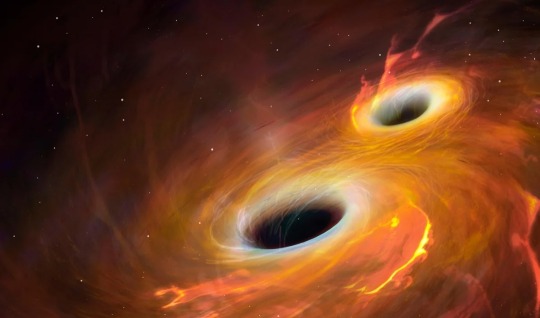
So what happens, then, if a propagating gravitational wave generated by a black hole-black hole merger runs into another black hole: one that didn’t play a part in the generation of those waves?
The two main options you’d likely consider are that it could pass though the black hole the way it passed through everything else, or it could be swallowed and absorbed by the black hole, adding to its mass/energy. Here’s how to puzzle out which one would actually occur.

Let’s start with black holes: objects that are not to be trifled with in the Universe. When you’re far away from a black hole’s event horizon, it appears to behave just like any other ordinary mass in the Universe. From the location of Earth, for example, the gravitational effects that we experience from our Sun are indistinguishable from the ones that would be generated by:
a white dwarf,
a neutron star,
or a black hole,
of the same exact mass.

We would still experience the same orbit, with the same speed, the same period, and the same elliptical pattern (and even the same level of relativistic precession) that we experience from our Sun. The only differences that would be perceptible would appear when we looked in the vicinity of the Sun (or whatever replaced it) itself. The bending of background starlight, along with all other forms of matter and radiation, is intensified the closer and closer you get to a compact, massive object: regions that are currently obscured by the disk of the Sun.
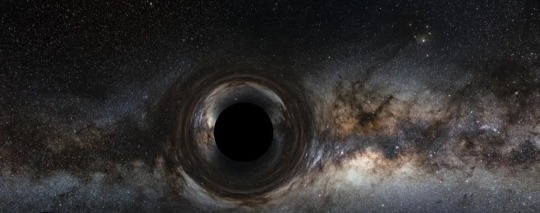
Other than the distortion of space from the innermost ~1 degree closest to the center of the Sun, where the curvature of space is most severe, there are no other detectable differences.
But that inner region of space matters tremendously when we consider the impact it has on absorbing various types of matter and radiation. For example:
the Sun, being an opaque object, would absorb everything that it interacts with, like protons, neutrons, electrons, and photons, but would be transparent to particles like neutrinos and antineutrinos,
white dwarfs, being opaque but much smaller than the Sun, would have a much smaller cross-sectional area (perhaps only ~0.01% that of the Sun) but would still be opaque to protons, neutrons, electrons, and photons, and due to its density would begin absorbing a small fraction of the neutrinos that strike it,
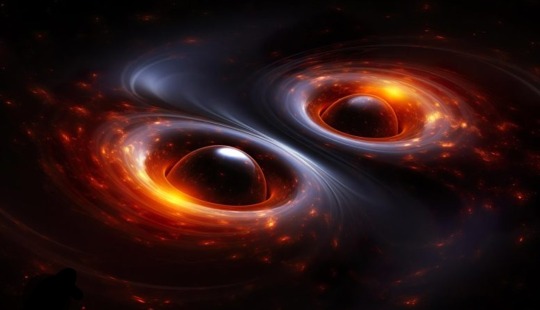
neutron stars, even smaller and denser than white dwarfs, have a much lower area over which they absorb protons, neutrons, electron, and photons, but will absorb ~100% of the ones that strike it, along with up to ~50% of the neutrinos (and antineutrinos) that pass through its diameter,
and black holes absorb absolutely 100% of everything we know of that touches or crosses its event horizon.
From a black hole, if you’re an energy-carrying entity, there ought to be no escape.
Originally published on https://bigthink.com
COMING UP!!
(Saturday, December 7th, 2024)
"HOW TO DESTROY A BLACK HOLE????"
#astronomy#outer space#alternate universe#astrophysics#universe#spacecraft#white universe#space#parallel universe#astrophotography
31 notes
·
View notes
Text

Finally! New art! I’m sorry for not posting for a while, I’ve honesty just not have any art to post really, mostly just sketches and one thing I want to post alongside another piece I’ve yet to finish. But now I have something! And it’s Red riding hood!
I actually drew like two preliminary sketches of this idea before sitting down and starting on this drawing, the things that changed from the first ones to this one was mostly the pose, and the decision to have the ears and tail not be “real” (I’ve got real attached to the monster au design where she always has the big wolf ears and tail, but I decided that I need to allow her to go without those for some instances, especially when she’s just in the standard movie universe. But I also didn’t want to not draw them so we ended up with this, which I think I also did for an early drawing for her back in 2020).
Any way, hope you enjoy werewolf gf.
(ID in alt and under cut)
[ID:
A digital drawing of Red riding hood from red shoes and the seven dwarfs. She’s posed learning over a pink flower in her hand, smiling brightly at it. She has a pair of floating ears above her head and tail floating behind her, she also notably has large dark claws. The background is a star filled sky, with a gibbous moon placed behind her head, creating a halo like effect. In the lower left corner is a signature reading “Cookieek”.
End of ID.]
49 notes
·
View notes
Text
Masterpost of my fics and ideas.
All links for finished stories are to AO3.
Also if anyone wants to basically rewrite or write a fic based on mine please do and as long as they have a happy ending please send me a link.
My Star Wars Anakin/Padme fake dating happy ending fic. Titled Jedi Can't.
My partner and I's Dragon Age Inquisition fic about Cullen being a thirst trap for Thedas basically. Titled Commander Fancy Pecs.
A Lord of the Rings Legolas as a child with his parents. Titled Bedtime Storytime for Little Legolas.
A Lord of the Rings, Gimli/Legolas fic. Titled Secret.
The Hobbit Fili/OC dwarf Titled Once Upon a Battlefield.
The Hobbit Bilbo/Thorin miscommunication fic Titled Khuzdul (Not So) Fluent.
The Hobbit Balin/Dori with background Thorin/Bilbo/Dwalin. Balin confesses to Dori. Titled A Gentle Nudge.
The Hobbit gen fic that is just fun about Dwarrow messing with Elves and Elves actually trying to be a good host. Titled Rivendell and a Joke.
The Hobbit fic that has both Bilbo/Thorin and Kili/Tauriel but isn't really focused on the relationships, just a fun idea where mithril comes from. Titled Not So Pointless.
The Hobbit Bilbo/Thorin short fic Titled Missing Touch.
The Hobbit basically a gen fic Titled Touch.
One of my longer The Hobbit fics with Thorin/Bilbo and an accidental proposal. Titled Our Home.
The Hobbit, probably my most popular fic. Thorin/Bilbo Time travel fix it fic technically everyone dies but Bilbo gets sent back to fix it. Titled A Dream of Something More. There is an epilogue to this one that is posted separately A Dream or Something More Epilogue.
The Hobbit Thorin/Tauriel fic that was written as a gift. Little bit of a sex scene. Titled Mel Asar.
The Hobbit pre Thorin/Tauriel realtionship fic also written as a gift, had an idea about them meeting for the first time. Titled First Meetings.
The only Harry Potter fic I got written before the JK issues really came to light. It's Draco/Harry. Titled Firewhiskey Secrets.
The Hobbit Thorin/Bilbo fic miscommunication but also sweet and short. Titled Hairwash With Love
--WIPS--
My oldest wip written for Beauty and the Beast, no it is actually not abandoned, I will update someday! Titled A True Beast?.
The Hobbit Thorin/Bilbo fic about a very anxious Bilbo who loves architecture. Also not abandoned, someday my brain will work again!Titled Anxiety.
I would absolutely love nearly any kind of comment from emojis to paragraphs, just nothing rude please.
Ideas for more stories. These links are all on Tumblr
The Hobbit/The Lord of The Rings Collection
Sherlock Collection
#the hobbit#dragon age inquisition#the lord of the rings#star wars#my fics#please comment#thilbo bagginshield#bagginshield#gigolas#padme amidala#anakin and padme#anakin skywalker#inquisitor x cullen#commander cullen#kiliel#sherlock#johnlock
102 notes
·
View notes
Photo

Planetary Nebula Abell 7 : Very faint planetary nebula Abell 7 is some 1,800 light-years distant, just south of Orion in planet Earth's skies in the constellation Lepus, The Hare. Surrounded by Milky Way stars and near the line-of-sight to distant background galaxies, its generally simple spherical shape, about 8 light-years in diameter, is outlined in this deep telescopic image. Within its confines are beautiful, more complex details enhanced by the use of narrowband filters. Emission from hydrogen is shown in reddish hues with oxygen emission mapped to green and blue colors, giving Abell 7 a natural appearance that would otherwise be much too faint to be appreciated by eye. A planetary nebula represents a very brief final phase in stellar evolution that our own Sun will experience 5 billion years hence, as the nebula's central, once sun-like star shrugs off its outer layers. Abell 7 itself is estimated to be 20,000 years old. Its central star is seen here as a fading white dwarf some 10 billion years old. via NASA
596 notes
·
View notes
Photo

Jones-Emberson 1, 2024-07-12
Planetary nebula Jones-Emberson 1 is the death shroud of a dying Sun-like star. It lies some 1,600 light-years from Earth toward the sharp-eyed constellation Lynx. About 4 light-years across, the expanding remnant of the dying star's atmosphere was shrugged off into interstellar space, as the star's central supply of hydrogen and then helium for fusion was depleted after billions of years. Visible near the center of the planetary nebula is what remains of the stellar core, a blue-hot white dwarf star. Also known as PK 164 +31.1, the nebula is faint and very difficult to glimpse at a telescope's eyepiece. But this deep image combining over 12 hours of exposure time does show it off in exceptional detail. Stars within our own Milky Way galaxy as well as background galaxies across the universe are scattered through the clear field of view. Ephemeral on the cosmic stage, Jones-Emberson 1 will fade away over the next few thousand years. Its hot, central white dwarf star will take billions of years to cool.
Credits: NASA's 'Astronomy Picture Of The Day.'
51 notes
·
View notes
Text

Text id is under readmore
[id: A phoenix rises from burning ruins of buildings that are dwarfed by it. The phoenix and the ruins are all red, green, white and black (the colors of the Palestinian flag) and the phoenix has a half moon and a five pointed star (a symbol of Islam) in its eyes. The background is beige. Text above it reads "Won't be Silenced", text below it and the ruins reads "Won't be Erased". end id]
118 notes
·
View notes
Video
Spiral from the side by European Space Agency Via Flickr: What kind of astronomical object is this? It doesn’t look quite like the kinds of galaxies, nebulae, star clusters or galaxy clusters which Hubble normally brings us images of. In fact, this is a spiral galaxy, named UGC 10043 — we just happen to be seeing it directly from the side! Located roughly 150 million light-years from Earth in the constellation Serpens, UGC 10043 is one of the somewhat rare spiral galaxies that are seen edge-on. From this point of view, we see the galaxy’s disc as a sharp line through space, overlain with a prominent dust lane. This dust is spread across the spiral arms of UGC 10043, but it looks very thick and cloudy when viewed from the side. You can even see the lights of some active star-forming regions in the arms, shining out from behind the dust. Strikingly, we can also see that the centre of the galaxy sports a glowing, almost egg-shaped ‘bulge’, rising far above and below the disc. All spiral galaxies have a bulge like this one as part of their structure, containing stars that orbit the galactic centre on paths above and below the whirling disc; it’s a feature that isn’t normally obvious in pictures of galaxies. The unusually large size of this bulge compared to the galaxy’s disc is possibly thanks to UGC 10043 siphoning material from a nearby dwarf galaxy. This may also be why the disc is warped, bending up at one end and down at the other. Like most of the full-colour Hubble images released by ESA/Hubble, this image is a composite, made up of several individual snapshots taken by Hubble at different times and capturing different wavelengths of light. You can see the exact images used in the sidebar on this page. A notable aspect of this image is that the two sets of Hubble data used were collected 23 years apart, in 2000 and 2023! Hubble’s longevity doesn’t just afford us the ability to produce new and better images of old targets; it also provides a long-term archive of data which only becomes more and more useful to astronomers. [Image Description: A spiral galaxy seen directly from the side, such that its disc looks like a narrow diagonal band across the image. A band of dark dust covers the disc in the centre most of the way out to the ends, and the disc glows around that. In the centre a whitish circle of light bulges out above and below the disc. The tips of the disc are a bit bent. The background is black and mostly empty.] Credits: ESA/Hubble & NASA, R. Windhorst, W. Keel; CC BY 4.0
#UGC 10043#ESA#European Space Agency#Space#Universe#Cosmos#Space Science#Science#Space Technology#Tech#Technology#HST#Hubble Space Telescope#Galaxy#Supernova#NASA#Creative Commons#Stars#Star#Serpens#Spiral Galaxy#flickr
13 notes
·
View notes
Text
Reds and Blues, D&D Style
Simmons: Chthonic Tiefling Wizard with a Scribe background and Evoker subclass
Caboose: Cloud Giant Goliath Wizard with a Hermit background and Necromancer subclass
Grif: Hill Dwarf Bard with an Entertainer background and College of Lore subclass
Sarge: Rock Gnome Barbarian with a Sailor background and Path of the Berserker Subclass
Tucker: Blue Dragonborn Fighter with a Guard background and Champion subclass
Church: Aasimar Sorcerer with a Sage background and Clockwork Sorcery (Alpha)/Aberrant Sorcery (Epsilon) subclasses
Donut: Lightfoot Halfling Warlock with a Farmer background and Great Old One Patron subclass
Wash: Elf Rogue with a Wayfarer background and Soulknife subclass
Doc: Human Cleric with an Acolyte background and Life Domain subclass for himself, but a Charlatan background and Trickery Domain subclass for O'Malley
Lopez: Human Druid with an Artisan background and Circle of the Stars subclass
Tex: Half-Orc Ranger with a Soldier background and Hunter subclass
Carolina: Half-Elf Monk with a Noble background and Warrior of the Open Hand subclass
Locus: Orc Paladin with a Criminal background and Oath of Vengeance subclass (changes to the Oath of Devotion after his Heel Face Turn)
Sister: Hill Dwarf Bard with an Entertainer background and College of Dance subclass
#Red vs. Blue#Richard Simmons#Michael J. Caboose#Dexter Grif#RVB Sarge#Lavernius Tucker#Leonard L. Church#Franklin Delano Donut#Agent Washington#Frank DuFresne#RVB Lopez#Agent Texas#Agent Carolina#RVB Locus#Kaikaina Grif#i just find the idea of Lopez the robot being a human druid very funny#he ONLY speaks Druidic though so no one understands him here either#Donut pretty much literally got a Great Old One Patron in canon with Chrovos#Shh i know they got rid of the School of Necromancy subclass i simply do not accept it#when i say Sarge was a Sailor i mean he was a Pirate obviously#Wash had one Wood Elf parent and one Drow parent#Carolina has a High Elf father and had a human mother
15 notes
·
View notes
Text
WHY IS PLUTO NOT A PLANET ANYMORE??
Blog#399
Wednesday, May 8th, 2024.
Welcome back,
Textbooks had to be rewritten. Members of the public were outraged. Our understanding of the solar system itself was forever changed on Aug. 24, 2006, when researchers at the International Astronomical Union (IAU) voted to reclassify Pluto, changing its status from a planet to a dwarf planet — a relegation that was largely seen as a demotion and which continues to have reverberations to this day.

Today, the debate about Pluto exposes difficulties in the definition of "planet." The IAU defines a planet as a celestial body orbiting the sun, with a nearly spherical appearance, and that has (for the most part) cleared debris from its orbital neighborhood. But even this set of metrics is not universally agreed upon.
Earth, and even Jupiter, have not cleared many asteroids from their orbital regions despite their large size. Moreover, there are small worlds that are circular and that orbit the sun and yet are not considered planets, such as Ceres.
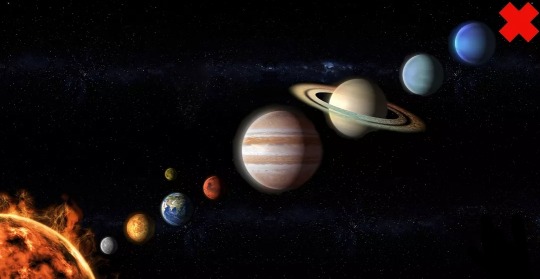
Pluto's so-called demotion from planetary status raises larger issues about how to define any object in the solar system, or even in space more generally. It shows that science cannot, sometimes, slot objects into easy categories. Because if the definition of a planet once again widens, it is unclear how to assess the numerous non-circular objects that circle our sun. This may even put the asteroid belt into question, referring to the huge band of small objects between Mars and Jupiter. Or what happens if a planet is somehow broken up into pieces?
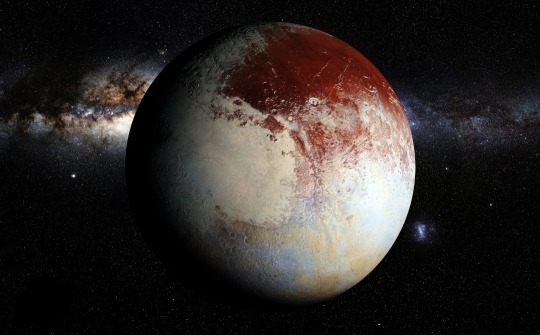
All the same, as the Pluto debate took place almost 20 years ago, many still don't quite understand all the fuss, nor why Pluto was knocked from its planetary position. But the solar system's transformation from nine planets to eight (at least by the standard IAU definition) was a long time in the making and helps encapsulate one of the greatest strengths of science — the ability to alter seemingly steadfast definitions in light of new evidence.
The word planet (in English) stretches back to antiquity, deriving from the Greek word "planetes," which means "wandering star."
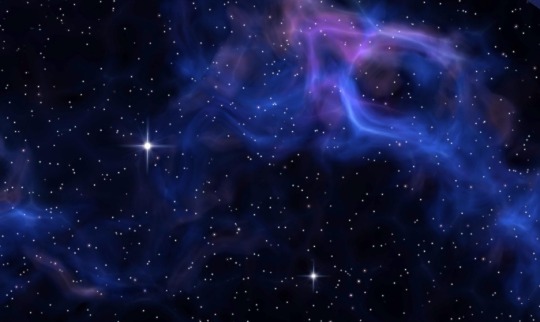
The five classical planets — Mercury, Venus, Mars, Jupiter and Saturn — are visible to the naked eye and can be seen shifting in strange pathways across the sky compared with the more distant background stars.
After the advent of telescopes, astronomers discovered two new planets, Uranus and Neptune, which are too faint to spot with the naked eye
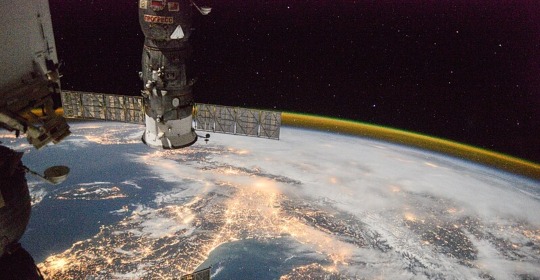
(Note that this definition of "planet" is following the Greco-Roman tradition on which the International Astronomical Union or IAU's community definitions are based. The names of planets vary by culture and the naked-eye planets were observed around the world during antiquity.)
When astronomers discovered Ceres (today considered a dwarf planet), they initially categorized it as a "planet" among scientific communities of the day. But that began to change as further measurements showed it was smaller than other planets ever seen at the time. Eventually, Ceres was lumped into a group of rocky bodies, called "asteroids", of which we now know of hundreds of thousands of these in the asteroid belt alone.

Pluto was found and classified as a planet in 1930 (note the IAU was formed in 1919) when astronomer Clyde Tombaugh of the Lowell Observatory in Arizona compared photographic plates of the sky on separate nights and noticed a tiny dot that drifted back and forth against the backdrop of stars. Right away, the solar system's newest candidate was considered an oddball, however. Its orbit is so eccentric, or far from circular, that it actually gets closer to the sun than Neptune for 20 of its 248-years-long trip. It also is tilted to the ecliptic, which is the plane upon which the other solar system planets orbit.
Originally published on www.space.com
COMING UP!!
(Saturday, May 11th, 2024)
"THE UNIVERSE COULD BE FILLED WITH ULTRALIGHT BLACK HOLES THAT CAN'T DIE??"
#astronomy#outer space#alternate universe#astrophysics#universe#spacecraft#white universe#space#parallel universe#astrophotography
72 notes
·
View notes
Text

INTRODUCING: FALK WHITE
Full Name: Falk Soren White
Birthdate: December 24th, 1997
Hair Color: Dark Brown
Eye Color: Brown
Species: Human
Family: Queen Snow White (Mother), King Florian (Father), Seraphina White (Younger Sister), Evil Queen Grimhilde (Step-Grandmother), Evie Grimhilde (Step-Aunt)
Love Interest: Tabby Andrews
Friends: Tee Wiley, Ben Beast, Petra Müller, Greer Grimm, Minty Liddell, June of Agrabah, Willa Darling, Doug Dwarf, Carlos de Vil
Likes: Running, Pokémon, video games, challenges, animals, cleaning, sports, music, romance, sweet food
Dislikes: Laziness, uncleanliness, boredom, apples, public speaking, being in the spotlight
Phobias: Heights
Style: Athletic wear when he's running, otherwise he wears lots of silk shirts, loafers, suits, literally Mr. Fancy Pants
Speech: Soft spoken but knows how to get loud and will when he's intoxicated, rarely swears, likes to make random noises when he's nervous
Physical Quirks/Scars: Lots of little knacks and bruises at all times from being so active, always smells like cleaner
Personality: Athletic, clean, challenger, nervous, quiet, scattered, a bit chaotic, kind, animal lover
Background: Born and raised in the White Kingdom, Prince Falk has been media trained his whole life, from the very first season of The Real Housewives of Auradon, in which he was still a toddler, to his mother's endeavors in journalism, Falk and his little sister Seraphina have only ever known a life in the spotlight. Then again, what else is expected of a future King? Still, Falk never much enjoyed being in the public eye, preferring enough privacy to go about his athletic endeavors and spending much of his free time in Auradon's animal park. When his mother agrees to star in a reunion special of The Real Housewives, Falk begs to be sent to Auradon Prep to escape more cameras. There, he is immediately well-loved, as he has no qualms cleaning people's rooms when he gets nervous or doing their homework to take some workload off them. He's well-respected as one of the fastest runners on the school's team as well. When the VKs come to Auradon, Falk can hardly seem to get away from his step-aunt Evie, who seems to want to know as much as she can about him. When Falk is suddenly poisoned, all his loved ones can hope for is that true love's kiss really can cure all curses.
Faceclaim: Michael Cimino
TAGLIST: @eddysocs @ocs-supporting-ocs @foxesandmagic @veetlegeuse @decennia @hiddenqveendom @arrthurpendragon @luucypevensie @nikosasaki @noratilney @wordspin-shares @oneirataxia-girl @endless-oc-creations @stelstellakidd @andromedalestrange @far-shores @daughter-of-melpomene @bibaybe
15 notes
·
View notes
Text

New SpaceTime out Friday
SpaceTime 20240920 Series 27 Episode 114
Did dwarf planet Ceres originate in the asteroid belt?
A new study has raised fresh questions about the origin of the dwarf planet Ceres – the largest body in the main asteroid belt between Mars and Jupiter.




A galactic mystery about Dark matter and stars finally solved
Astronomers have overturned the longstanding idea that stars and dark matter are interacting in inexplicable ways.



China's secretive spaceplane returns to Earth
China's highly secretive reusable experimental spacecraft has successfully returned to Earth following a 268-day orbital mission.




The Science Report
Using cruciferous vegetables to lower high blood pressure.
Study shows larger bumblebees fly faster, but that middle-aged bees fly longer and further.
Study shows dogs can remember the names of objects two years after learning them.
Skeptics guide to Wycliffe Well - the UFO capital of Australia!
SpaceTime covers the latest news in astronomy & space sciences.
The show is available every Monday, Wednesday and Friday through Apple Podcasts (itunes), Stitcher, Google Podcast, Pocketcasts, SoundCloud, Bitez.com, YouTube, your favourite podcast download provider, and from www.spacetimewithstuartgary.com
SpaceTime is also broadcast through the National Science Foundation on Science Zone Radio and on both i-heart Radio and Tune-In Radio.
SpaceTime daily news blog: http://spacetimewithstuartgary.tumblr.com/
SpaceTime facebook: www.facebook.com/spacetimewithstuartgary
SpaceTime Instagram @spacetimewithstuartgary
SpaceTime twitter feed @stuartgary
SpaceTime YouTube: @SpaceTimewithStuartGary
SpaceTime -- A brief history
SpaceTime is Australia’s most popular and respected astronomy and space science news program – averaging over two million downloads every year. We’re also number five in the United States. The show reports on the latest stories and discoveries making news in astronomy, space flight, and science. SpaceTime features weekly interviews with leading Australian scientists about their research. The show began life in 1995 as ‘StarStuff’ on the Australian Broadcasting Corporation’s (ABC) NewsRadio network. Award winning investigative reporter Stuart Gary created the program during more than fifteen years as NewsRadio’s evening anchor and Science Editor. Gary’s always loved science. He studied astronomy at university and was invited to undertake a PHD in astrophysics, but instead focused on his career in journalism and radio broadcasting. Gary’s radio career stretches back some 34 years including 26 at the ABC. He worked as an announcer and music DJ in commercial radio, before becoming a journalist and eventually joining ABC News and Current Affairs. He was part of the team that set up ABC NewsRadio and became one of its first on air presenters. When asked to put his science background to use, Gary developed StarStuff which he wrote, produced and hosted, consistently achieving 9 per cent of the national Australian radio audience based on the ABC’s Nielsen ratings survey figures for the five major Australian metro markets: Sydney, Melbourne, Brisbane, Adelaide, and Perth. The StarStuff podcast was published on line by ABC Science -- achieving over 1.3 million downloads annually. However, after some 20 years, the show finally wrapped up in December 2015 following ABC funding cuts, and a redirection of available finances to increase sports and horse racing coverage. Rather than continue with the ABC, Gary resigned so that he could keep the show going independently. StarStuff was rebranded as “SpaceTime”, with the first episode being broadcast in February 2016. Over the years, SpaceTime has grown, more than doubling its former ABC audience numbers and expanding to include new segments such as the Science Report -- which provides a wrap of general science news, weekly skeptical science features, special reports looking at the latest computer and technology news, and Skywatch – which provides a monthly guide to the night skies. The show is published three times weekly (every Monday, Wednesday and Friday) and available from the United States National Science Foundation on Science Zone Radio, and through both i-heart Radio and Tune-In Radio.
#science#space#astronomy#physics#news#nasa#astrophysics#esa#spacetimewithstuartgary#starstuff#spacetime#jwst#nasa photos#james webb space telescope#hubble telescope#hubble#hubble space telescope#galaxy#planet
14 notes
·
View notes
